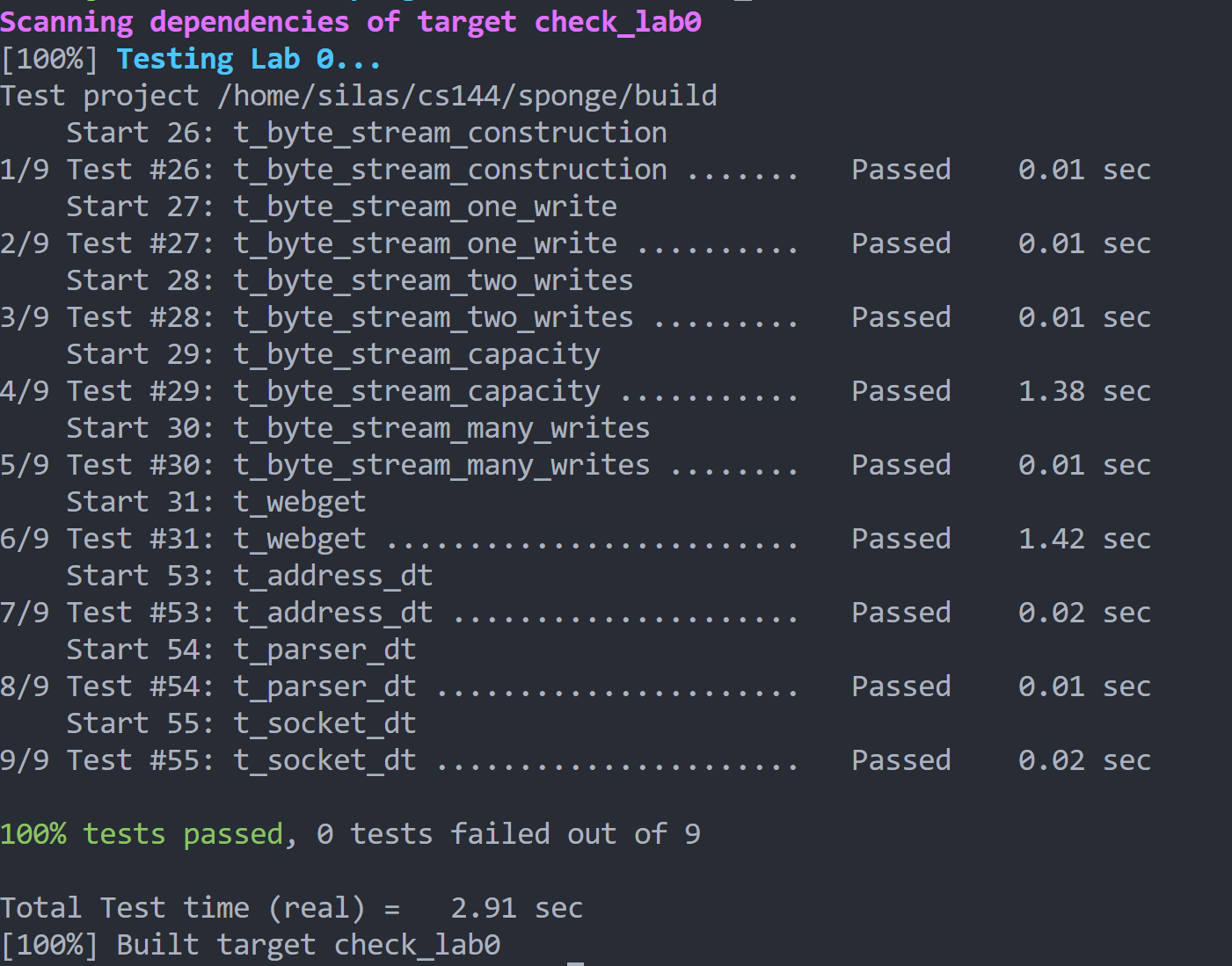关于现代 C++,CS144建议以下几点:
- Use the language documentation at https://en.cppreference.com as a resource.
- Never use
malloc() or free().
- Never use
new or delete.
- Essentially never use raw pointers (*), and use “smart” pointers (unique ptr or shared ptr) only when necessary(You will not need to use these in CS144.)
- Avoid templates, threads, locks, and virtual functions. (You will not need to use these in CS144.)
- Avoid C-style strings (
char *str) or string functions (strlen(), strcpy()). These are pretty error-prone. Use a std::string instead
- Never use C-style casts (e.g., (FILE *)x). Use a C++ static cast if you have to (you generally will not need this in CS144).
- Prefer passing function arguments by const reference (e.g.: const Address & address).
- Make every variable const unless it needs to be mutated.
- Make every method const unless it needs to mutate the object.
- Avoid global variables, and give every variable the smallest scope possible.
- Before handing in an assignment, please run make format to normalize the coding style
感觉还是挺严格的,不知道实际工程项目当中是不是也有类似的要求
这个就是让我们熟悉一下 Socket 的 API 如何使用,刚开始不太理解,没仔细看实验手册给的链接
仔细看下给的 TCPSocket 的使用发现其实就是首先客户端和服务器建立连接,然后客户端向服务器发送请求,最后读取服务器响应的内容,代码如下:
注意:请求报文的换行是 \r\n 并且请求结束时要多加一个换行
1
2
3
4
5
6
7
8
9
10
11
12
13
14
15
16
17
18
19
20
21
22
23
24
|
void get_URL(const string &host, const string &path) {
// Your code here.
TCPSocket sock;
sock.connect(Address(host, "http"));
sock.write("GET " + path + " HTTP/1.1\r\n");
sock.write("Host: " + host + "\r\n");
sock.write("Connection: close\r\n\r\n");
// sock.shutdown(SHUT_WR);
while (!sock.eof()) {
cout << sock.read();
}
sock.close();
// You will need to connect to the "http" service on
// the computer whose name is in the "host" string,
// then request the URL path given in the "path" string.
// Then you'll need to print out everything the server sends back,
// (not just one call to read() -- everything) until you reach
// the "eof" (end of file).
// cerr << "Function called: get_URL(" << host << ", " << path << ").\n";
// cerr << "Warning: get_URL() has not been implemented yet.\n";
}
|
完成测试的样子:
![https://silas-py-oss.oss-cn-chengdu.aliyuncs.com/img/20220725130555.png https://silas-py-oss.oss-cn-chengdu.aliyuncs.com/img/20220725130555.png]()
这个就是实现一个可靠的字节流,类似于管道,从一端写入,另外一端读取,这样的话用双端队列 deque 比较合适
下面是添加在头文件中的变量:
1
2
3
4
5
6
7
8
9
10
11
12
13
14
15
16
17
|
class ByteStream {
private:
// Your code here -- add private members as necessary.
std::deque<char> buffer;
size_t cap;
size_t size = 0;
size_t read_len = false;
size_t write_len = false;
bool input_end = false;
// Hint: This doesn't need to be a sophisticated data structure at
// all, but if any of your tests are taking longer than a second,
// that's a sign that you probably want to keep exploring
// different approaches.
bool _error{}; //!< Flag indicating that the stream suffered an error.
//...
}
|
然后是具体 ByteStream 的实现,比较重要的是 eof 的判断,也是参考了其他博客的思路,当字符流也就是 buffer 为空了,并且没有继续输入的字符也就是 input_end 结束了,就达到 eof 了
然后踩坑的地方:当实现完的时候,以为直接结束了,可以测试,然后一直通不过,也不知道啥原因,后来发现需要先 make 把错误代码改过来,并且编译一下,然后再make check_lab0 就可以测试了
然后就是我写代码过程中发现的错误:C++的列表初始化顺序要和变量定义的顺序一致(感觉之前C++白学了,笑)
1
2
3
4
5
6
7
8
9
10
11
12
13
14
15
16
17
18
19
20
21
22
23
24
25
26
27
28
29
30
31
32
33
34
35
36
37
38
39
40
41
42
43
44
45
46
47
48
49
50
51
52
53
54
55
56
57
58
59
60
61
62
63
64
65
66
67
68
69
70
71
72
73
74
75
76
77
78
79
80
81
82
83
|
#include "byte_stream.hh"
// Dummy implementation of a flow-controlled in-memory byte stream.
// For Lab 0, please replace with a real implementation that passes the
// automated checks run by `make check_lab0`.
// You will need to add private members to the class declaration in `byte_stream.hh`
template <typename... Targs>
void DUMMY_CODE(Targs &&... /* unused */) {}
using namespace std;
ByteStream::ByteStream(const size_t capacity) : buffer(capacity), cap(capacity) {
buffer.erase(buffer.begin(), buffer.end());
}
size_t ByteStream::write(const string &data) {
if (input_end) {
return 0;
}
size_t pre = buffer.size();
for (char c : data) {
if (buffer.size() < this->cap) {
buffer.push_back(c);
this->write_len++;
} else {
break;
}
}
return buffer.size() - pre;
}
//! \param[in] len bytes will be copied from the output side of the buffer
string ByteStream::peek_output(const size_t len) const {
string ans;
size_t i = 0;
for (auto it = buffer.begin(); it != buffer.end() && i < len;
++it, ++i) {
ans.push_back(*it);
}
return ans;
}
//! \param[in] len bytes will be removed from the output side of the buffer
void ByteStream::pop_output(const size_t len) {
for (size_t i = 0; i < len && !buffer.empty(); i++) {
buffer.pop_front();
this->read_len++;
}
}
//! Read (i.e., copy and then pop) the next "len" bytes of the stream
//! \param[in] len bytes will be popped and returned
//! \returns a string
std::string ByteStream::read(const size_t len) {
string ans;
size_t i = 0;
for (auto it = buffer.begin();
it != buffer.end() && i < len && !buffer.empty(); ++it, ++i) {
ans.push_back(*it);
buffer.pop_front();
this->read_len++;
}
return ans;
}
void ByteStream::end_input() { input_end = true; }
bool ByteStream::input_ended() const { return input_end; }
size_t ByteStream::buffer_size() const { return buffer.size(); }
bool ByteStream::buffer_empty() const { return buffer.empty(); }
bool ByteStream::eof() const { return buffer.empty() && this->input_end; }
size_t ByteStream::bytes_written() const { return this->write_len; }
size_t ByteStream::bytes_read() const { return this->read_len; }
size_t ByteStream::remaining_capacity() const { return this->cap - buffer.size(); }
|
完结证明:
![https://silas-py-oss.oss-cn-chengdu.aliyuncs.com/img/20220725102612.png https://silas-py-oss.oss-cn-chengdu.aliyuncs.com/img/20220725102612.png]()
lab0 其实花了我挺久的,大概3-4小时,主要是刚开始没反应过来先 make 一下测试代码编译是否正确

